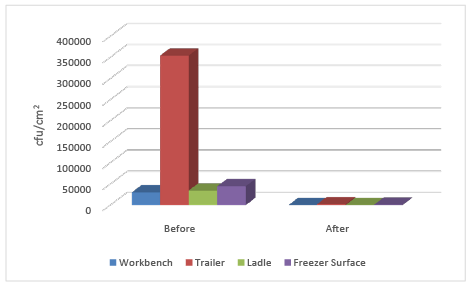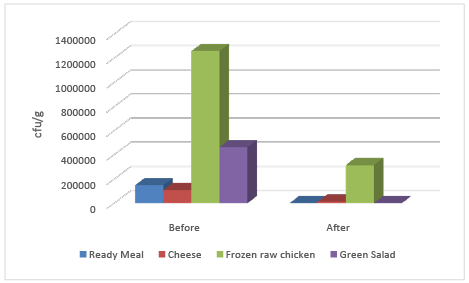
Figure 1: Total plate count values of different surfaces before and after the diagnostic studies at a representative health unit.


Efstathia Tsakali Olga Gortzi Dimitrios Timpis John Tsaknis*
Department of Food Technology, Technological Educational Institute of Athens, Greece*Corresponding author: John Tsaknis, Department of Food Technology, Technological Educational Institute of Athens, Athens, Greece, E-mail: jtsaknis@teiath.gr
Food safety and hygiene is always a very interesting and timely issue, because it directly affects public health, and demonstrates the cultural level of each state, especially after the constant crises in the food chain. In recent years food crises, have been recorded both at a local and at the international level regarding the safety of meals in hospitals, with a significant impact on patients’ confidence. The public awareness led to the total redefinition of addressing food security from the initial production stage to the final consumption point. Estiasis- an European Union and Greece co-founded program undertook initiatives and targeted actions in the direction of Food safety and Hygiene management in Hospitals, nursing homes and Infirmaries of Chronic Diseases.
The importance of food safety and hygiene is even more critical for the food service of the hospitals, nursing houses and clinics of chronic diseases, and this is basically because in the hospital setting, the offered meals catered to patients are a part of the overall care for their recovery. So, food becomes a major factor that, at least in terms of safety, can aggravate the health of the patients (who are mostly sensitive to hospital or other infections and requiring special diets: anal, parenteral, etc.) and should be monitored for both substantive and legal reasons [1]. Of course food safety is not only necessary for patients but for all people catered in health facilities, including staff and visitors.
Cases of food borne illnesses in hospitals, may lead to serious diseases, the treatment of which is costly and there is the possibility of spreading to other patients [2,3]. A case of food borne salmonellosis was recorded in Greece in July 2005, at a University Hospital. In particular, Salmonella enterica was detected both to patients and employees (two of which were asymptomatic employees of the food service) but also in processed cheese kept under refrigeration. However, it was not detected in the unprocessed cheese, a strong indication that the contamination took place during processing (cross-contamination through the food kitchen equipment) [4].
Many cases of food poisoning could have been avoided if the appropriate food safety and hygiene standards had been applied. However, it should be noted that the application of the HACCP principles in health units have specific peculiarities, as hospital food services have significant differences in relation to other food service sectors [5]. In particularity, the multidisciplinary involved personnel make difficult the appropriate training [6]. Also, the number of specialized formulations/recipes and their methods of preparation are significantly large. On the other hand, patients differ from the general population in terms of their needs and their resistance to any lower quality food, due to their weak immune system. The risks that may arise can be more, since the supplies cover almost the entire spectrum of the food market as meals vary depending on the feeding requirements, and the final product is not as standardized as in the food industry. Furthermore, the catering services harmonize with the rest of the hospital services, since it is not an independent activity of the organization. The staff of the food services of hospitals is not always qualified especially since hospitals cannot afford the budget of the food industry for laboratory equipment and quality control. The key role for the reduction or even elimination of food-borne problems should belong to prevention, since the audits/checks carried out by various government agencies, such as the Food Safety Agency and other Health Services, simply detect the problem but they cannot solve it.
In view of lack of modern approaches and integrated processes, with respect to the Quality and Food Safety at the premises of mass catering of Hospitals, nursing houses and Infirmaries of Chronic Diseases, the Department of Food Technology, of the Technological Educational Institute of Athens undertaken initiatives and targeted actions in this direction.
The Estiasis project with 38 scientists of different specialties involved, started in 2012 and finished in 2015. The first stage of the program was focused on the design and the development of intervention programs for food safety management. Fifteen health sites were selected throughout Greece and they were assessed for their level of implementation of the requirements of food hygiene standards. The process included, diagnostic studies and mapping of the existing practices, conduction of successive tests on the prevailing conditions in production areas and equipment, consecutive microbiological and chemical analyzes in food materials, prepared meals and surfaces for risk identification and definition of Critical Control Points (CCP’s) and finally creation of corrective action reports for each health unit.
Based on the foundings and the diagnostic studies, which reflected the existing situation in all units a Template Manual of Food Hygiene and Safety was designed, in accordance with the requirements of ISO 22000:2005 standard. The prepared manual corresponded to actual realistic facts and it could be used also by other Hospitals, Nursing homes and Clinics of Chronic diseases with suitable small adjustments, where appropriate[7].
The next step was the creation of original informative material for the employees of the health units for the effective implementation of food hygiene and safety and the requirements of the legislation. Towards this direction, a-10 hours-seminar took place in each health site for the awareness of the employees. Finally, games such as crosswords, quizzes, puzzles but also interactive ones in electronic form were designed in order to sensitize children on the importance of healthy and safe food. All these materials were sent to 187 health units all over the country.
After the completion of the corrective actions and the education of the staff, the facilities which met the requirements of the ISO 22000:2005 standard were certified by an independent agency.
For the dissemination of the importance of the Estiasis actions, a web site was created, three workshops took place and there were several publications in the local press.
From the beginning of the Estiasis project and based both on the scientific experience of the research team and literature review [8], it was obvious that the role of the food handlers’ awareness, training and practices were key elements for the success of a Food Safety System for public catering units.
The first proofs of this consideration came already with the results of the surfaces’ microbiological testing before and after the diagnostic studies for each health unit. The results of the original testing where disappointing and the diagnostic studies emphasized on ways of improving cleaning/ sanitation. The response was immediate and the new sampling after the briefing of the employees about the original foundings but also for ways of improvement, showed a profound reduction of the microbiological index values that in some cases reached 99.97% (Figure 1).

Figure 1: Total plate count values of different surfaces before and after the diagnostic studies at a representative health unit.
This first achievement towards better food safety operations was encouraging and a second step for the awareness of the food handlers was made, with training seminars on food hygiene and safety, with emphasis on the importance of personal hygiene and good practices. In order to demonstrate the importance of the hygiene practices of the handlers samples of food were taken prior and after the training seminars. Again, the results were impressive. The reduction of microbiological index values was great and especially in processed meals where the impact of handlers’ good practices is crucial. The raw materials were better preserved and showed a reduction of the total plate count value by 75.0% while ready meals were better prepared and showed a reduction of 99.5% and 99.9% for cooked meals and fresh green salads respectively (Figure 2).

Figure 2: Total plate count values of food samples before and after the training seminars on food hygiene and safety at a representative health unit.
The profits of the implementation of the Estiasis project actions were several. Firstly, the better internal organization leads to reduced operating costs, thus continuous improvement. A better use of the resources was achieved. The easy way to detect problems helps in their effective resolution even before they become visible. The satisfaction of patients is a strong key for better treatment conditions while ISO 2200:2005 certifications assists in the increased trust to the hospitals and the legal recognition. Finally better working conditions for the staff lead in capacity utilization.
The writers acknowledge the support they received through the Operational Program “Human Resources Development” of the National Strategic Reference Framework (NSRF)-Research Funding Program: ESTIASI - Systemic Interventions MIS 372969, co-financed by the EU (European Social Fund – ESF) and Greek national funds.
Download Provisional PDF Here
Article Type: Short Communication
Citation: Tsakali E, Gortzi O, Timpis D, Tsaknis J (2016) Food Safety and Quality Control in the Public Catering Sector-Intervention Programs. Nutr Food Technol 2(3): doi http://dx.doi.org/10.16966/2470- 6086.126
Copyright: © 2016 Tsakali E, et al. This is an open-access article distributed under the terms of the Creative Commons Attribution License, which permits unrestricted use, distribution, and reproduction in any medium, provided the original author and source are credited.
Publication history:
All Sci Forschen Journals are Open Access